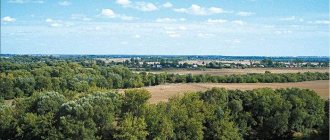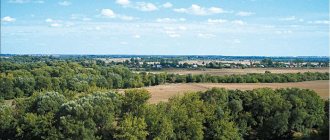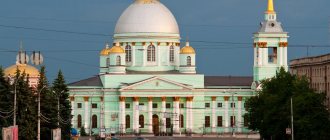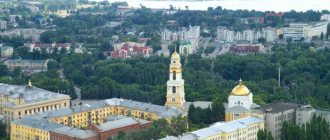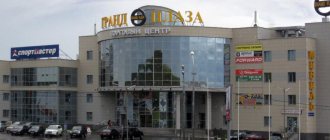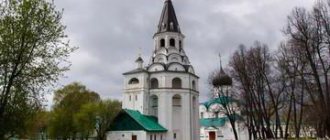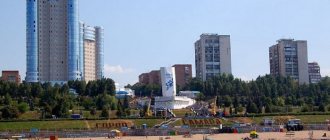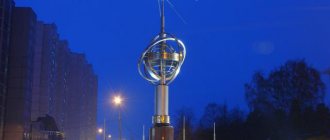The city of Kursk is located in the European part of our country, a little more than five hundred kilometers south of Moscow. Currently it is the administrative center of the Kursk region. Its historical part is located on two hills, along the right bank of the Tuskar River. The name of the city, according to the official version, comes from the Kur River, which flows into the Tuskar River at this point. It is believed that the Kur used to be more full-flowing and the establishment of a settlement here, and subsequently the construction of a fortress, was quite reasonable. The popular version of the name of the city leans more towards the partridge bird, which was found in large numbers in these parts. She is even depicted on the city's coat of arms. The first mention of Kursk was in the Life of Theodosius of Pechersk (1008 - 1074, one of the founders of the Kiev Pechersk Lavra) and dates back to 1032. Most likely, there was a large settlement here before, but only the year 1032 is documented. The countdown of the age of Kursk begins with it. According to the Laurentian Chronicle (written in 1377 by the monk Laurentius for Prince Dmitry, later called Donskoy), the Principality of Kursk was formed in 1095. Its first prince was Izyaslav Vladimirovich (1077 - 1096, second son of Vladimir Monomakh and the English princess Gita of Wessex). He built a fortress in the city, and Kursk became an important outpost of Kievan Rus.
At the beginning of the 13th century, the Mongol invasion of Rus' began. The first battle took place on the Kalka River in 1223. The troops of a number of principalities of Rus', in alliance with the Polovtsians, opposed the Mongols. Representatives of the Kursk Principality also took part in the battle. Due to the lack of general unity of command, the Battle of Kalka was lost. You can learn about this historical moment from the article “Kozelsk”. The final conquest of Rus' occurred a little later, during the Western Campaign of the Mongols (1236 - 1242) under the leadership of Batu Khan (1209 - 1255, Batu Khan, grandson of Genghis Khan). Kursk resisted the Mongols and was completely destroyed in 1238. These were difficult times not only for the city, but for all of Rus'. However, the Russian people are very stubborn, and gradually the city was rebuilt. A few decades later, the problem repeated itself. In 1285, Nogai's horde (1240 - 1300) again destroyed Kursk. At the cost of enormous efforts, the city was restored again.
In 1362, the Lithuanian prince Olgerd (1296 - 1377, son of Gediminas) captured the city and annexed it to the Grand Duchy of Lithuania. For many years, Kursk was a Lithuanian city and only in 1508 it became part of the Grand Duchy of Moscow. However, this did not give much development to the city. At that time it remained the outskirts of the principality. Constant raids by Crimean Tatars and other nomads led to a decrease in population and a decline in crafts. By the end of the 16th century, it was decided to raise the importance of Kursk. A new fortress was erected here, the walls of which reliably protected people from the enemy. Some residents were resettled from a number of neighboring cities to Kursk. These efforts were not in vain, the city came to life and began to develop. Subsequently, there were still attempts by Polish-Lithuanian troops to capture the city, as well as raids by the Crimean Tatars, which haunted the residents of Kursk. At the slightest danger, people took refuge in the fortress, and its garrison repelled all attacks. The city became a serious stronghold of the country. Gradually, the borders of the state expanded, and Kursk turned into an industrial city.
Under Empress Catherine II (1729 - 1796), the territorial division in the central part of the Russian Empire was changed. Along with others, the Kursk governorate was created in 1775. The city of Kursk becomes its center. Even Belgorod was part of the Kursk governorship for some time. At the beginning of 1797, Emperor Paul I (1754 - 1801, son of Catherine II) abolished all governorships and made Kursk the center of the Kursk province.
Kursk has always been an Orthodox city. It remains the same in our time. There are a large number of Orthodox churches here, each of which has its own distant history. One of the pearls of Orthodoxy, without a doubt, is the Kursk Root Icon. At the site of her discovery, a monastery subsequently arose.
History of conferring the honorary title “City of Military Glory”
At the beginning of the Great Patriotic War, Kursk was defended not only by the Red Army, but also by the people's militia.
On November 3, 1941, Kursk was captured by the Germans. During the occupation of the city (from June 1942 to February 1943), an underground sabotage and reconnaissance group led by locomotive driver G.P. operated in the Kirovsky district of the city. Babkin. The underground took part in sabotage at the railway junction, in rescuing wounded Soviet pilots K.K. from captivity. Gluzhitsky, N.K. Evgrafova, P.I. Bubekova, T.M. Bomko and others.
During the occupation, the damage caused to citizens of the Kirov region amounted to 10,595,449 rubles, 51.6 thousand square meters of housing were destroyed and burned. 246 houses were destroyed and 606 required major repairs.
On the morning of February 8, 1943, the Kirovsky district of Kursk and the railway junction were liberated by soldiers of the 1033rd Infantry Regiment of the 280th Infantry Division and the 248th Separate Cadet Brigade of Colonel I.A. Gusev. During the preparation and conduct of the Battle of Kursk, the railway workers of the Kursk junction, in the conditions of the most severe raids and bombings of enemy aircraft, ensured the advancement of military echelons. On November 5, 1943, the first of the Kursk residents, the head of the Kursk station, Pyotr Alekseevich Shubin, was awarded the title of Hero of Socialist Labor. The strategic talent of Soviet commanders was revealed in the Battle of Kursk. The operational art and tactics of military leaders showed superiority over the German classical school: second echelons in the offensive, powerful mobile groups, and strong reserves began to emerge. During the 50-day battles, Soviet troops defeated 30 German divisions, including 7 tank divisions. The total losses of the enemy amounted to more than 500 thousand people, up to 1.5 thousand tanks, 3 thousand guns and mortars, more than 3.5 thousand aircraft.
Near Kursk, the Wehrmacht military machine suffered such a blow, after which the outcome of the war was actually predetermined. This was a radical change in the course of the war, forcing many politicians on all warring sides to reconsider their positions. The successes of the Soviet troops in the summer of 1943 had a profound influence on the work of the Tehran Conference, in which the leaders of the countries participating in the anti-Hitler coalition took part, and on its decision to open a second front in Europe in May 1944.
Shipping
The Sejm has long been used for transporting people and goods. In the Middle Ages, the river was the only safe and fast way to travel. It connected the Dnieper, Volga and Don, allowing free trade with Byzantium, Volga Bulgaria, and the peoples on the shores of the Black and Caspian Seas.
We recommend reading: River Pra: map, description, characteristics, rafting and fishing
The first shipping company was founded in Kursk by Governor A. N. Zubov. This happened in 1780. Barges loaded with products went to the Seim after the end of the icebreaker. Then the ships reached the Desna, from there they went to the Dnieper, and there they reached the Black Sea. In two months the barges reached the city of Kherson.
This waterway was used by a Nizhny Novgorod merchant named Gekov. He managed to navigate at least three barges loaded with grain and bread along the river. His journey was extremely difficult, because many merchants refused to use the river to transport goods.
In 1817, several more barges reached Kherson, with a total value of goods of 40 thousand rubles. The long journey was also not without incidents and losses. Barges capsized or became stuck in shallow water.
It was possible to eliminate the troubles associated with the winding banks of the river, shallow water and a large number of built mills only after the construction of a lock system in 1839.
The author of the project was M. A. Puzanov. He was considered the best hydraulic engineer. Thanks to his project, 60 piers and 17 locks were erected on the river. After their construction, the river became safer.
The waterway created by Puzanov was nicknamed Alexandria in honor of Empress Alexandra, the wife of Nicholas I. In 1843, 24 barges were carried along it.
In May 1846, the Lyudinovo steamship, which was the property of the merchant Maltsev, arrived in Kursk for the first time. The ship's captain found the lock system usable. But it existed only until the middle of the 19th century. By this time, the locks themselves had worn out, and shipping communications had become unprofitable.
During the Soviet period, the river was used to transport passengers. Motor ships of the Zarya type cruised around the Seim.
Nowadays, the river is navigable only in the lower reaches to the village of Verbovka, Chernihiv region; in other sections you can only see fishing boats of Seim residents and small boats used to transport tourists.
Recommended reading: the ancient name of the Volga.
The city during the Second World War
With the beginning of the Great Patriotic War, many Kursk residents went to the front for mobilization. About 1,500 applications from volunteers were submitted to the city's district military registration and enlistment offices. Among them were 302 statements from communists and 400 statements from women. Weapons began to be produced in the city: grenades, combustible mixture for fighting tanks. In the very first days of the war, the city party committee and the defense committee created fighter battalions to protect enterprises, maintain order in the city and fight saboteurs. Several thousand city residents voluntarily joined four militia regiments. For air defense, 409 self-defense groups were created. More than 11 thousand residents took part in them. More than 20 thousand people worked on the construction of defensive lines around the city. Firing points and barricades were built in Kursk itself.
On August 29, 1941, enemy aircraft bombed the Kursk railway junction for the first time. From that day on, German planes appeared over the city almost every day. On September 13, the Kursk Regional Party Committee decided to mobilize communists and Komsomol members, which played a significant role in strengthening the city’s defense. In October, when Hitler’s troops approached the city, workers from the northern and western locomotive depots and car repair point built an armored train, without drawings or materials, and handed it over to units of the Red Army. Then another armored train was built.
The commissar of the people's militia regiment of the Leninsky district, K. Ivanov, reporting to the regional party committee about the regiment's military operations during the defense of the city, wrote that the battle for Kursk began on November 2, 1941, at 7:30 am. During the first half of the day, fighters of the 3rd battalion fought in the area of the brick-and-mortar plant, near the Fatezhskoe highway. Here the enemy suffered serious damage: the 9th company alone destroyed at least 300 fascists. In the middle of the day, the battalion retreated to the next line, which was occupied by soldiers of the 1st and 2nd battalions. The battle lasted for several hours. Only in the 2nd half of the day, under pressure from superior enemy forces, when there was a threat of encirclement, the regiment occupied a new line - barricades along Lenin, Gogolevskaya and Mirnaya streets. At this line the regiment fought until the evening of November 2.
The Nazis tried many times to seize the barricades on Lenin and Gogolevskaya streets, but they failed. The mortar installed by the Germans on the square opposite the medical institute was immediately destroyed by a group of fighters led by the commander and assistant commander of the 1st company, Grigoryan and Korotkikh, who fired from the windows of the second floor of the former building of the regional party committee. Then the Germans brought up an anti-tank gun, from which they opened direct fire at the barricades. But our soldiers destroyed her servants.
The battle on the barricades lasted about four hours. Only at six o’clock in the evening, when enemy units, having gone out through the gardens to Chelyuskintsev Street, bypassed our fighters, the militia retreated to the yeast factory, and then crossed the Tuskar River at the Battle Dacha. After the command's order, on the night of November 3, Kursk was abandoned by our troops.
Nazi troops stayed in Kursk for over 450 days and nights. Hunger, devastation, executions, the crying of Kursk residents driven into captivity... Almost three thousand shot, ten thousand driven to Germany, over ten thousand died of hunger - this is the bloody trace of the occupation. But even during the occupation, the people of Kursk waged an active struggle against the Nazi invaders. Residents of the city supported the partisans and helped captured Soviet officers and soldiers escape from fascist captivity.
The Nazi occupiers established a bloody terrorist regime in the temporarily occupied areas of the region, as a result of which 13 thousand were shot and 44 thousand residents of the cities and villages of the Kursk Territory were taken to hard labor in Germany. The invaders were especially atrocious in the western regions of the region.
The occupation caused enormous damage to the economy of the region. Two-thirds of industrial enterprises were destroyed, including all sugar factories. Agriculture suffered greatly. The Germans destroyed all MTS. On collective farms, 54 thousand industrial buildings and 83 thousand houses of collective farmers were destroyed. The Nazis destroyed and exported to Germany 114.4 thousand heads of cattle, 153 thousand sheep, 112 thousand pigs, etc.
During the occupation, the sown area decreased catastrophically: it was only 40 percent of the pre-war one, and industrial crops of sugar beets disappeared completely. In total, up to 2 million hectares of arable land were turned into fallow land and overgrown with weeds. The main tools for cultivating the land, as a hundred years ago, were a shovel and a plow, which the peasants themselves were forced to harness. As a result, cultivation of the land sharply deteriorated, and crop rotations introduced before the war were disrupted. All this sharply reduced productivity.
Sejm
In its size it differs from other rivers of the Kursk region. The Seym is a large tributary of the Desna, the width of which in the lower reaches is up to 100 m. The river bed, 500 km long, is located among picturesque landscapes. The main part of its tributaries (900 in total) are located here. These include Svapa, Kleven and Tuskar. The length of 7 tributaries flowing into the river in Ukrainian valleys is about 10 km.
As the river flows, it forms a large number of bends. It has different banks, one of which is quite steep and acts like a cliff. However, at the beginning of the journey both banks are flat. Due to the fact that the river has a slight slope, its flow is slow, although in ancient times it was navigable. The bottom in the upper reaches of the Seim is loamy, then it changes to sandy loam, and below it becomes sandy.
There is a lot of fish in the river waters and lakes located in the nearby valleys. You can find varieties such as tench and rudd. Of the plants listed in the Red Book of Russia, gladiolus grows here, and in the river itself there is a white water lily. The gladiolus meadow is located near the floodplain and adjoins the Glushkovsky district nature reserve near the village of Karyzh. A considerable part of the river's coastal area is covered by a pine forest in which rare species of trees grow: Manchurian walnut, Weymouth and Crimean pine.
Merits of the city in the military history of Russia
Archaeological research shows that on the site of the current Znamensky Monastery of Kursk there existed a large settlement no later than the 8th century. Kursk was first mentioned in the Life of Theodosius of Pechersk (not earlier than 1032, when the Dnieper left bank came into the possession of Yaroslav the Wise). In this chronicle, Kursk is described as a large city with developed trade and a significant number of inhabitants; was part of Chernigov, then Pereyaslavl and Novgorod-Seversky principalities. The first mention in the Laurentian Chronicle is in 1095. The year 1095 is also considered the year of the founding of the Kursk appanage principality, which existed in the 11th-13th centuries.
The first Kursk prince was Izyaslav Vladimirovich, son of Vladimir Monomakh; Izyaslav built a fortress in Kursk, and from the end of the 11th century it was one of the most powerful outposts on the border of Kievan Rus (the original Kursk fortifications were dismantled in the middle of the 17th century). In 1185, Prince Vsevolod of Kursk, who also ruled in Trubchevsk, sent a squad against the Polovtsians; This unsuccessful campaign of the Russian princes is described in “The Tale of Igor’s Campaign.” Later, the Kursk people took part in the Battle of Kalka. In 1238, the city was completely destroyed by the Tatar-Mongols, after which the principality was actually ruled by the khan's baskak, who bought tribute to the principality from the khan of the Golden Horde. In 1285, Kursk was again ravaged to the ground by Nogai's horde in response to the performance of the Rylsk and Vorgol princes Oleg, together with the Lipetsk prince Svyatoslav, against the Tatar Baskak Akhmet in 1283.
From 1362 (when the Lithuanian prince Olgerd took possession of the city) until the end of the 15th century, Kursk was part of the Grand Duchy of Lithuania. As “Kuresk on Tuskor” it is mentioned in the chronicle “List of Russian cities far and near” among the cities of Kyiv (Since 1362, Kyiv and the territories related to it were part of the Grand Duchy of Lithuania). The Lithuanian city of Kursk is mentioned in the treaty with the Teutonic Order in 1402. In the 16th-17th centuries, Kursk was an important defensive point of the Grand Duchy of Moscow (it became part of it in 1508) on the borders with the Polish-Lithuanian Commonwealth and the Wild Field. There are known mentions of Kursk in the “Book of the Big Drawing” (1517), in the decree of Ivan IV the Terrible (1582; the sovereign ordered the exile of “kromeshniks, rebels, rebels” “to the outlying cities of Sevsk and Kursk”). In the 15th - early 16th centuries, raids by the Crimean Tatars and Nogais led to the desolation of the city.
However, a century later the city re-emerged in a new location; The date of the refounding of Kursk is considered to be 1586. In 1596, a new fortress was built, the garrison of which in 1616 numbered over 1.3 thousand people. At the beginning of the 17th century, Kursk was repeatedly attacked by Polish-Lithuanian troops (in 1612, 1616, 1617, 1634), Crimean Tatars, and Nogais, but the Kursk fortress was never taken. Residents from Orel and other southern Russian cities were resettled to Kursk (in 1678, Kursk already had 2.8 thousand inhabitants). After the great fire that devastated Kursk in 1781, a new general plan of the city was adopted, according to which the central position was to be occupied by shopping arcades (which were erected on the central square, called Red). In 1768, the stone Ilinskaya Church appeared (it was famous for its choir of singers), in 1778 the Sergius-Kazan Cathedral was built in the Baroque style; By 1778, the Trinity-Sergius Cathedral with rich interior decoration was completed.
On September 20, 1919, volunteer troops under the command of General Denikin entered the city. On November 19, 1919, Kursk was taken by the Red Army.
On August 29, 1941, Kursk was subjected to the first bombing by German aircraft. At the beginning of November, German troops approached the city, and on November 1-2 there were defensive battles for the city.
On the night of November 3, Kursk was surrendered to the enemy.
The city suffered greatly during the fighting during the liberation from the German occupation, which lasted until February 8, 1943, when the city was liberated by the 60th Army under the command of General I.D. Chernyakhovsky.
The Battle of Kursk (July 5, 1943 - August 23, 1943) is also memorable in its scope, the forces and means involved, tension, results and military-political consequences; it is one of the key battles of the Great Patriotic War.
Psel
The length of the Psel River bed in the Kursk region is more than 200 km, the rest falls on Ukrainian territory (about 500 kilometers). Of the 25 existing tributaries, the largest merge with the river in the middle of its course. The length of the right tributary Grun is 55 km. The Khorol River, which carries its waters for 300 km, flows into Psel on the left side. Some places are characterized by high swampiness.
The Psel River itself is distinguished by a calm flow, spacious sandy banks and varied vegetation. It is shallow, with a beautiful winding channel and asymmetrical banks. The bottom is mostly sandy, sometimes muddy. There are aquatic inhabitants, of which there are up to 50 species. There are hares and foxes on the banks, and in the thick of the forest you can encounter roe deer and wild boar.
The most significant military events associated with the city
The Battle of Kursk is the largest tank battle in history; About two million people, six thousand tanks, and four thousand aircraft took part in it.
The battle is the most important part of the strategic plan of the summer-autumn campaign of 1943, according to Soviet and Russian historiography it includes: Kursk strategic defensive operation (July 5-23), Oryol (July 12 - August 18) and Belgorod-Kharkov (August 3-23 ) strategic offensive operations. The battle lasted 49 days. The German side called the offensive part of the battle Operation Citadel.
As a result of the offensive according to the Kutuzov plan, the Oryol group of German troops was defeated and the Oryol strategic bridgehead occupied by it was eliminated. During Operation Commander Rumyantsev, the Belgorod-Kharkov group of Germans ceased to exist and this important bridgehead was eliminated. The radical turning point in the course of the Great Patriotic War, which began at Stalingrad, was completed during the Battle of Kursk and the Battle of the Dnieper, and during the subsequent Tehran Conference, on the initiative of F. Roosevelt, the plan he personally compiled “2 months ago for the division of Germany into five states” was already discussed "
After the end of the battle, the strategic initiative finally passed to the side of the Red Army, which continued to liberate the country from the German invaders and carried out mainly offensive operations until the end of the war. August 23 is the Day of Military Glory of Russia - the Day of the defeat of Nazi troops by Soviet troops in the Battle of Kursk (1943).
General information
The rivers of this region represent a very extensive network. All of them belong to the plain type and are not particularly deep. They mainly cover the central and western part of the region (80%), adjacent to the Dnieper basin. This includes the largest rivers, such as the Seim and Psel, with their numerous tributaries. The rest (20%) in the eastern part of the region formed a network that merges with the Don basin. For example, Olym, Tim, Oskol, Kshen. In total, the length of the river network is approximately 8000 km. You may be interested to know where the rivers of the Kursk region flow, as well as what kind of vegetation surrounds them.
Merits of the city's rear
With the beginning of the Great Patriotic War, many Kursk residents went to the front for mobilization.
Weapons began to be produced in the city: grenades, combustible mixture for fighting tanks.
After the liberation of 30 districts of the Kursk region from the Nazi invaders, the population donated 558 thousand pounds of various grain crops and 130 thousand pounds of meat to the Red Army fund.
The involvement of the population of the Kursk region in the construction of defensive structures began at the end of February 1943, when, by decree of the Military Council of the Voronezh Front, 50,000 residents of the region and 2,250 carts were mobilized. In March 1943, the Military Councils of the Central and Voronezh Fronts recruited another 32,200 people to build defense lines. In early April, more than 200,000 residents of the region came out to build defensive lines, airfields, and airplane runways. The first field airfield, built with the participation of residents of the Kastoreni region, began receiving aircraft on March 24, 1943.
The military command set a responsible task - to turn every populated area and every combat line into defense nodes. During the construction of the rear army and front lines of the Central Front, up to 1 million cubic meters of earthworks were carried out during May 1943. Residents of Kursk, Stary, Novy Oskol, Oboyan, Valuyek, and Yelets put a lot of work into defense construction.
If in April 1943, 105 thousand workers and collective farmers of the Kursk region participated in the creation of defensive lines on the Kursk ledge, then in June - more than 300 thousand residents of the Oryol, Kursk, and Voronezh regions.
In each region, columns were created, divided into detachments and platoons, in which the mobilized population participated in defensive work. On June 13, 1943, Kurskaya Pravda wrote in its editorial: “The construction of defensive lines, the strengthening of every city, village, and railway station is the work of all the working people of the region. We are taking an exam before the front. And therefore, how well and quickly we carry out defensive work, the Red Army, our brother warriors will judge our readiness to help them in military affairs ... "
A state defense line was built along the left bank of the Don. Hundreds of thousands of residents of the Oryol and Voronezh regions erected defensive lines on the Don and along the Oskol River.
The tactical defense zone reached a depth of 15-20 km and had the largest number of engineering structures.
The amount of engineering work performed was enormous. Of the 2,590 kilometers of defensive lines of the Central and Voronezh fronts, the workers of the Kursk region built 2,040 kilometers. In the Voronezh Front alone, 83,912 rifle and machine-gun trenches, 17,505 shelters and dugouts were opened, the length of trenches and communication passages reached 4,240 kilometers. In total, more than 10 thousand kilometers of trenches and communication passages were dug in the zones of the Central and Voronezh fronts.
The workers of Kursk worked on the defensive lines for more than 408 thousand man-days, removed 275 thousand cubic meters of soil, and produced 13,000 cubic meters of concrete and brickwork. On the approaches to Kursk they built 130 artillery installations, 900 bunkers, 46 earthen ramparts, and barricades were erected on the streets.
A team of young builders from the Oboyansky district, led by Komsomol member Ivan Fedichev, fulfilled more than two standards from the first days of work.
1,300 Komsomol members of the Lgov region, united in 72 Komsomol youth brigades, systematically fulfilled the plan by 150%. The brigades of N. Loskutova, M. Zharkikh, and A. Korovina distinguished themselves in the construction of lines in the zone of the 38th and 60th armies.
In May 1943, 900 Komsomol members of the Svobodinsky district worked as part of the 34th Defense Construction Directorate of the Central Front. The teams of Z. Rossiysky, Z. Kobzeva, A. Delov, E. Safronova, V. Peshkova, A. Gladkova, who completed 140% of their daily tasks, especially distinguished themselves in their work.
The youth of the region surrounded the defenders of their native land with care and attention. In May 1943 alone, 2,369 individual gifts were sent to units of the Central Front from young people. This work was especially active in the Dmitrievsky and Lgovsky districts.
The youth of the region provided great assistance to more than 30 hospitals located in the region. More than 20,600 mattresses, blankets, pillows, sheets, towels, and more than 46 thousand spoons, bowls, forks, plates, and glasses were collected for them. 85 tons of milk, 100 thousand eggs, more than 8.5 tons of sour cream, butter and other products were donated to hospitals. This work was especially widespread in the Oboyansky, Belovsky, Pristensky, Mikhailovsky, and Svobodinsky districts. 1,300 young sanitary workers worked in hospitals in Kursk and the region, helping to receive and evacuate wounded soldiers.
In Kursk, 5,275 girls and women donors gave 1,179 liters of blood for the wounded during the fighting on the Kursk Bulge. The initiators of the donor movement in the region were Komsomol members of the Dzerzhinsky district of Kursk. 10 Komsomol sergeants were awarded medals “For Military Merit”.
More than 213 thousand wounded were treated in 28 hospitals in Kursk during the Battle of Kursk. So many of the fired fighters were returned to service that they were enough to form several divisions.
The given figures and facts indicate the great contribution of the working people of the Kursk region to the victory of Soviet troops on the Kursk Bulge.
Spring flood
The rivers of the Kursk region reach their highest level in the spring. In the last few decades, floods have become much less noticeable. The average duration of spring floods is about 20 days. This period varies depending on the size of the rivers and the terrain. On large flows it can last more than a month, and on small flows – up to 10 days. Near the Seim River this gap is quite significant, particularly within the lowlands.
The water level begins to rise 6-7 days before the ice breaks up. This time usually occurs at the end of March - beginning of April. Ice movement occurs within 5 days, and on large rivers twice as long. By the end of April, the flood usually ends, and already in May the water level drops noticeably.
Military units and formations formed from the city population
In the very first days of the war, the city party committee and the defense committee created fighter battalions to protect enterprises, maintain order in the city and fight saboteurs. Several thousand city residents voluntarily joined four militia regiments. For air defense, 409 self-defense groups were created. More than 11 thousand residents took part in them. More than 20 thousand people worked on the construction of defensive lines around the city. Firing points and barricades were built in Kursk itself.
Tributaries
Over 900 rivers flow into the Seim, three of them are more than 100 km in length (Tuskar, Svapa in the Russian Federation and Kleven in Ukraine). The territory of the Kursk region has 639 tributaries, the length of 110 of them is more than 10 km. In Ukraine, only 7 rivers flowing into the Seim are longer than 10 km.
The largest tributaries are:
- Seimitsa Kotlubanskaya.
- Seimitsa Donetsk.
- Full.
- Tuskar.
- Big chicken.
- Reut.
- Prutishche.
- Swapa.
- Amonka.
- Snagost.
- Vir.
- Kleven.
- Ezuch.
Outstanding historical figures of Russia (natives of the city)
- Seraphim of Sarov (in the world Prokhor Isidorovich Moshnin) is the hieromonk of the Sarov Monastery, the founder and patron of the Diveevo Convent. Glorified by the Russian Church in 1903 as a saint on the initiative of Tsar Nicholas II. One of the most revered Russian saints.
- Konstantin Aleksandrovich Trutovsky is a Russian genre painter, illustrator of works by N.V. Gogol, M.Yu. Lermontova, I.A. Krylova, academician of the Imperial Academy of Arts, member of the Royal Belgian Watercolor Society.
- Nikita Sergeevich Khrushchev - First Secretary of the CPSU Central Committee, Chairman of the Council of Ministers of the USSR. Hero of the Soviet Union, three times Hero of Socialist Labor.
- Schwartz (Schwartz) Vyacheslav Grigorievich is a Russian painter, academician, honorary free associate of the Imperial Academy of Arts, founder of the historical and everyday genre in Russian painting.
- Shukhov Vladimir Grigorievich - Russian engineer, architect, inventor, scientist; Corresponding Member and Honorary Member of the USSR Academy of Sciences, Lenin Prize laureate, Hero of Socialist Labor.
Fishing and rafting
Seim is popular among fishing enthusiasts. After the end of spawning on the river, dozens and hundreds of people appear who want to sit on the bank with a fishing rod. Families come here; in the summer, tents and campfires appear near the Seim. The best time for fishing is June or July.
Perch, pike, and bream are caught using spinning rods and regular fishing rods. There are a lot of fish, chub and perch are hiding in the coastal reeds, and pike are lying in wait for their prey in the grass on the left bank. In the spring you can catch asp in the Seimas. This fish swims along with strong currents and melt waters from the Desna. After the water subsides, the asp returns to its native habitat.
Winter types of fishing are also in demand. They seriously prepare for ice fishing, stocking up on clothing and gear. In winter, the river freezes almost completely, but neither snow drifts nor blizzards stop experienced fishermen.
Kayaking is also popular. The tourist season begins in April and ends in November. All this time, continuous lines of kayaks stretch along the Seim. During the trip, many fish, sunbathe on the beach and visit attractions, the abundance of which is famous for the coastal cities and villages.
Business card of the city.
The visiting card of Kursk is the House of Soviets. On November 7, 1947, the House of Soviets, built according to the design of Alexei Shuklin, was solemnly commissioned in Kursk. Even before the Great Patriotic War, he became the winner of the competition for architectural designs for the main building of the region. Now the House of Soviets is the most important accent in the architectural appearance of Kursk. One cannot help but be surprised how wisely A.G. Shuklin chose the location for the building. Monumental, it simultaneously forms the main historical square of the city - Red, and, being at the junction of the central and busiest streets of Lenin and Dzerzhinsky, connects them with a beautiful square, ceremoniously rising in a large and colorful volume.
Indigenous deserts
Not far from the city of Kursk there is an ancient monastery of the Kursk Root Hermitage. It is located in the village. Svoboda, on the right bank of the Tuskar River. Entering the gates of the monastery, you will have to go down all the time, since many buildings and temples are built on steep slopes. It will take some effort to go down to the river and then back up, but this blue-turquoise splendor is worth it.
Internal staircase of the monastery
Appearance title
The etymology of the toponym is not clear to some researchers. Others have discerned the Indo-European root ke in the word, and translate the name as multi-colored. The generally accepted version is the one with the base syāma – dark, black river.
Let us say right away that the Polish representative body, the Sejm, has absolutely nothing to do with this.
Once upon a time the Sejm was much deeper and wider. He was respectfully called Big and Noble. The age of the river correlates with the age of the East European Plain where it flows.
